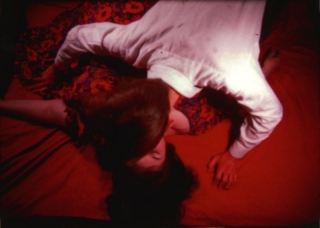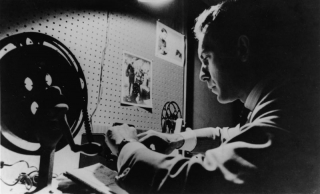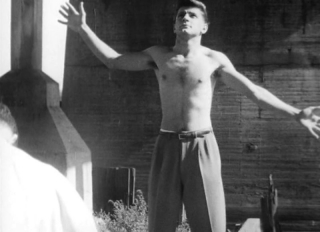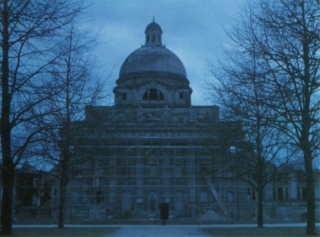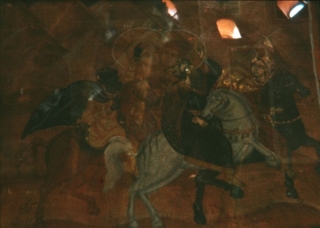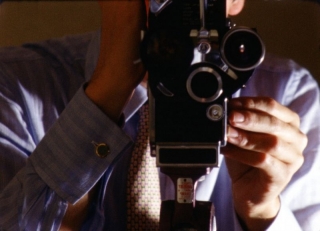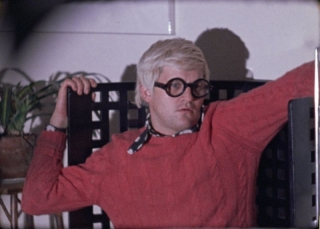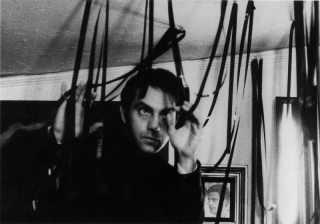Date: 2 August 2014 | Season: Gregory Markopoulos: Film as Film | Tags: Gregory Markopoulos
THE ILLIAC PASSION
Saturday 2 August 2014, at 2pm
Guanajuato Teatro Juarez
Gregory J. Markopoulos (1928-92) was one of the most original filmmakers to emerge from the post-war avant-garde. His films, which often translated literary or mythological sources to a contemporary context, are celebrated for their extraordinary creativity, the sensuous use of colour and innovations in cinematic form. In the 1960s, Markopoulos was actively involved in New York’s vibrant film community – the same milieu in which landmark works such as Scorpio Rising (Kenneth Anger), Flaming Creatures (Jack Smith) and The Chelsea Girls (Andy Warhol) first enraptured audiences. It was here that Markopoulos made one of his most celebrated films, The Illiac Passion, an extravagant interpretation of ‘Prometheus Bound’ populated with fantastic characters from the underground scene. Warhol appears as Poseidon, alongside Beverly Grant, Taylor Mead, Jack Smith, and other important figures. The soundtrack of this visionary re-imagining of the classical realm features a fractured reading of Thoreau’s translation of Aeschylus and excerpts from Bartók.
Gregory J. Markopoulos, The Illiac Passion, 1964-67, 92 min
This rare screening of The Illiac Passion celebrates the publication of Film as Film: The Collected Writings of Gregory J. Markopoulos (The Visible Press, 2014) and will be introduced by the book’s editor Mark Webber.
Also screening: 5 August 2014 at Mexico City Centro de Cultura Digital
PROGRAMME NOTES
THE ILLIAC PASSION
Saturday 2 August 2014, at 2pm
Guanajuato Teatro Juarez
THE ILLIAC PASSION
Gregory J. Markopoulos, USA, 1964-67, 16mm, sound, colour, 92 minutes
Inspired by Aeschylus’ Prometheus Bound. Music by Béla Bartok (excerpt from Cantata Profana). Voiceover by Gregory Markopoulos, reading from the American translation of Prometheus Bound by Henry David Thoreau. Costumes by Jerome Hiler.
Cast: Richard Beauvais (Prometheus), David Beauvais (his conscience), Robert Alvarez (Narcissus), Taylor Mead (the Demon or Sprite), Sheila Gary (Echo), Peggy Murray (the Muse), Tom Venturi (Hyacinthus), Tally Brown (Venus), Kenneth King (Adonis), gerard Malanga (Ganymede), Jack Smith (Orpheus), Jan Chipman (Eurydice), Andy Warhol (Poseidon), Phillip Klass (Daedelus), Margot Brier (Pandora), Paul Swan (Zeus), Wayne Weber (Icarus), Carlos Anduze (Hades), Stella Dundas (Moon Goddess), John Dowd (Endymion), Philip Marker (Apollo), Beverly Grant (Persephone / Demeter), Clara Hoover (Io), Gregory Battcock (Phaeton), and Gregory Markopoulos (as himself).
Back to top
Date: 8 September 2014 | Season: Gregory Markopoulos: Film as Film | Tags: Gregory Markopoulos
GREGORY J. MARKOPOULOS: FILM AS FILM
8—13 September 2014
New York Anthology Film Archives
“There is no language. There is no art. There is no knowledge. There is but film as film: the beginning and the eternal moment.” (The Intuition Space, 1973)
Gregory J. Markopoulos (1928-92) is one of the most original filmmakers to emerge from the post-war avant-garde. His films, which often translated literary or mythological sources to a contemporary context, are celebrated for their extraordinary creativity, the sensuous use of color and innovations in cinematic form. A co-founder of the New American Cinema Group, Markopoulos was actively involved in nurturing New York’s film community before moving to Europe at the end of the 1960s to pursue a more individual path. Firmly believing that a filmmaker should be responsibility for all aspects of his work, he developed the idea of Temenos, a monographic archive for the preservation, presentation and study of his films.
In parallel to his filmmaking, Markopoulos was a prolific writer whose articles were circulated in journals, self-published editions or program notes. This screening series celebrates the publication of Film as Film: The Collected Writings of Gregory J. Markopoulos, a new book that gathers together some ninety out-of-print or previously unavailable texts by the filmmaker. See www.thevisiblepress.com for more information on the book, and for details of additional events at Light Industry, The Kitchen, Harvard Film Archive and elsewhere this fall.
This is an extremely rare opportunity to see Markopoulos’ earliest works, shown alongside some of the first films made in Europe following his departure from the US in 1967. Robert Beavers and Mark Webber (the editor of “Film as Film”) will be present and the book will be available for purchase at the programmes.
Date: 8 September 2014 | Season: Gregory Markopoulos: Film as Film | Tags: Gregory Markopoulos
GREGORY J. MARKOPOULOS: FILM AS FILM 1
Monday 8 September 2014, at 7:30pm
New York Anthology Film Archives
Made as a USC student in Los Angeles, Markopoulos’ first 16mm film Psyche took as its source the unfinished novella of the same name by Pierre Louÿs. Shown together with Lysis and Charmides (both made on his return to Toledo, Ohio, and inspired by Platonic dialogues), it forms the trilogy titled Du sang de la volupte et de la mort (1947-48). By boldly addressing lesbian and homosexual themes, the trilogy gained unwelcome notices in Films in Review and Variety where, in the repressive atmosphere of the early 1950s, it was branded “degenerate” following a screening at NYU. Such a response is unimaginable today for lyrical works that express sensuality through the symbolic use of color and composition. Writing about these early films, Markopoulos chose to quote a statement by philosopher and theologian Mircea Eliade, offering viewers a clue to his entire body of work: “The whole man is engaged when he listens to myths and legends; consciously or not, their message is always deciphered and absorbed in the end.”
Gregory J. Markopoulos, A Christmas Carol, 1940, 5 min
Gregory J. Markopoulos, Du Sang, de la volupté et de la mort, 1947-48, 70 min (Essential Cinema)
Gregory J. Markopoulos, Christmas USA, 1949, 8 min
“The first thing which I did was to delete the novelette of its lush rhetoric and retain only its symbolic color. In Psyche, color plays an important role, similar to the role which color plays in the paintings of Toulouse Lautrec. Color reflects the true character of the individual before us, whether it be on the screen, in a painting, or in the street. Color is Eros.” (Psyche’s Search for the Herb of Invulnerability, 1955)
Date: 9 September 2014 | Season: Gregory Markopoulos: Film as Film | Tags: Gregory Markopoulos
GREGORY J. MARKOPOULOS: FILM AS FILM 2
Tuesday 9 September 2014, at 7:30pm
New York Anthology Film Archives
The Mysteries was made in Munich, Spring 1968, during the same period in which Markopoulos directed two opera pieces for German television. (Rosa von Praunheim was his assistant on all three projects.) Writing in Artforum, Kristin M. Jones described the film as “… a mournful work in which, as in many of the earlier films, the rhythmic repetition of imagery evokes poetic speech, and changes in costume emphasize shifts in time, space, and emotion. Here, a young man’s struggles with memories of love and intimations of death are set alternately to deafening silence and the music of Wagner.” The Swiss chateau built for Wagner by King Ludwig II is documented in Sorrows, an in-camera film composed through intricate layers of superimposition.
Gregory J. Markopoulos, Sorrows, 1969, 6 min
Gregory J. Markopoulos, The Mysteries, 1968, 80 min
“In my film I suggest that there is no greater mystery than that of the protagonists. War and Love are simply equated for what they are; the aftermath is inevitable, and a normal human condition, for which like the ancients one can only have pity and understanding. In this lies the mystery. All else is irrelevant. That there are other sub-currents of equal power in The Mysteries goes without saying; and, those who are capable of the numerous visual visitations and annunciations which the film offers them will realize what is the Ultimate Mystery of my work.” (Disclosed Knowledge, 1970)
Date: 10 September 2014 | Season: Gregory Markopoulos: Film as Film | Tags: Gregory Markopoulos
GREGORY J. MARKOPOULOS: FILM AS FILM 3
Wednesday 10 September 2014, at 7:30pm
New York Anthology Film Archives
“To be loved means to be consumed. To love means to radiate with inexhaustible light. To be loved is to pass away, to love is to endure.” (Text by Rainer Maria Rilke, recited on the soundtrack of Gammelion.)
Markopoulos’ elegant film of the castle of Roccasinibalda in Rieti, Italy, (then owned by patron, publisher and activist Caresse Crosby) employs an intricate system of fades to extend five minutes of footage to an hour of viewing time. This inventive new film form, in which brief images appear amongst measures of black and clear frames, was a crucial step towards Markopoulos’ monumental final work Eniaios (1947-91). This screening of Gammelion will be preceded by Bliss, a portrait of the interior of a Byzantine church on the Greek island of Hydra, edited in-camera in the moment of filming.
Gregory J. Markopoulos, Bliss, 1967, 6 min
Gregory J. Markopoulos, Gammelion, 1968, 55 min (Essential Cinema)
“Fortunate is the filmmaker who possesses a daemon, and who passes naturally from season to season, always with renewed energies, to that crucial point where he is able to recognize what constitutes the sunken attitudes of his art; what constitutes the portent, eagle-shaped attitudes. Attitudes which in a season of plenty soar beyond the frailties and grievances of the creative personality. Forgotten and released are the self-acknowledged limitations, the often comical, continuous demands upon friends and acquaintances in the name of one’s art. Finally, the total illusion that has been inherent from the beginning in one’s striving shimmers, quivers, and sets one aflame.” (Correspondences of Smell and Visuals, 1967)
Date: 11 September 2014 | Season: Gregory Markopoulos: Film as Film | Tags: Gregory Markopoulos
MARKOPOULOS/BEAVERS: EXPERIMENTAL FILMS/EXPERIMENTAL LIVES
Thursday 11 September 2014, at 7pm
New Haven Yale Whitney Humanities Center
Introduced and followed by a conversation with Mark Webber and Robert Beavers.
Gregory J. Markopoulos, Christmas USA, 1949, 8 min
Gregory J. Markopoulos, Through a Lens Brightly: Mark Turbyfill, 1967, 15 min
Robert Beavers, Early Monthly Segments, 1968-70/2000, 33 min
Gregory J. Markopoulos, Gilbert and George, 1970/1989-91, 12 min
Robert Beavers, Listening to the Space in My Room, 2010, 19 min
Presented by the Yale Film Studies Program, Hellenic Studies Program, Yale Film Colloquium, and Films at the Whitney.
PROGRAMME NOTES
MARKOPOULOS/BEAVERS: EXPERIMENTAL FILMS/EXPERIMENTAL LIVES
Thursday 11 September 2014, at 7pm
New Haven Yale Whitney Humanities Center
CHRISTMAS U.S.A.
Gregory J. Markopoulos, 1949, 16mm, 8 min
“The film is a subtly joyous depiction of sexual and sensual awakening – a celebration of a young man’s discovery of strange, exciting things lurking beyond the drab normality of the everyday. It’s a specific metaphor for Markopoulos’ homosexuality, of course, but also more generally for the sexual and intellectual awakenings of adolescence, the escape from the family to the individual life. That Markopoulos populates this moment with such wonder, passion, and mystical tension is a testament to his sure-handed ability to convey complex emotions cinematically, even at this early stage of his career.” (Ed Howard)
THROUGH A LENS BRIGHTLY: MARK TURBYFILL
Gregory J. Markopoulos, 1967, 16mm, colour, sound, 15 min
“One of the most accomplished works in Markopoulos’s series of film portraits, Through a Lens Brightly is a vivid study of the dancer and poet Mark Turbyfill that uses paintings and photographs in his home to recapture and illuminate a life in the arts.” (Harvard Film Archive)
EARLY MONTHLY SEGMENTS
Robert Beavers, 1968-70/2000, 35mm, colour, silent, 33 min
“Early Monthly Segments, filmed when Beavers was 18 and 19 years old, now forms the opening to his film cycle, “My Hand Outstretched to the Winged Distance and Sightless Measure.” It is a highly stylized work of self-portraiture, depicting filmmaker and companion Gregory J. Markopoulos in their Swiss apartment. The film functions as a diary, capturing aspects of home life with precise attention to detail, documenting the familiar with great love and transforming objects and ordinary personal effects into a highly charged work of homoeroticism.” (Susan Oxtoby)
GILBERT AND GEORGE
Gregory J. Markopoulos, 1970/1989-91, 16mm, colour, silent, 12 min
“Gregory Markopoulos’ Gilbert and George (1970) is a film marked by absence. Though a portrait of the artistic duo, the film indulges in none of the privileging of visibility on which the genre of portraiture often rests. Much of its twelve-minute duration is filled not with likenesses of the artists but with black and white leader. Occasionally a flash of image – a pair of feet, for example – will fill the screen for a brief moment before retreating again. The flow of movement, so crucial to most films, is missing. In its place is a rigorous engagement with the medium’s most basic elements, one that returns the viewer to the stillness of the individual film frame.” (Erika Balson)
LISTENING TO THE SPACE IN MY ROOM
Robert Beavers, 2010, 16mm, colour, sound, 19 min
“Ostensibly a portrait of a place where the artist had resided until recently, the film conjures not only the memory but also the physical presence of those who have previously stayed there. Adhering to a solitary intimacy while simultaneously acting as an ode to human endeavour and shared impulses toward fulfillment through art, Listening to the Space in my Room is a moving testament to existence (whose traces are found in literature, music, filmmaking, gardening) and our endless search for meaning and authenticity. The film’s precise yet enigmatic sound-image construction carries a rare emotional weight. ” (Andréa Picard)
Back to top
Date: 13 September 2014 | Season: Gregory Markopoulos: Film as Film | Tags: Gregory Markopoulos
GREGORY J. MARKOPOULOS: FILM AS FILM 4
Saturday 13 September 2014, at 3pm
New York Anthology Film Archives
Inspired by the legend of Faust, Genius is a triple-portrait of three significant art world figures – the British artist David Hockney, the Argentinian surrealist painter Leonor Fini, and the German-born art dealer Daniel-Henry Kahnweiler, an important early supporter of the Cubists. With its measured structure, carefully spacing images between passages of clear or opaque film, Genius forms the central section of the third cycle of Eniaios. This 80-hour long silent film, one of the most remarkable and ambitious projects in the history of cinema, is intended to be shown only at the remote site in Greece chosen by Markopoulos as the ideal setting for his work.
Gregory J. Markopoulos, Genius (from Eniaios III), 1970, 86 min
“In film, in the beautiful, stupid past of the commercial film with its total lack of creative achievement, though stated otherwise by film historians, the absolute Barbarians of our diminishing cultural age, the film construction was dependent on the story in the guise of the necessary message; the necessary message impounded for the benefit, that is the enlightenment and therefore the deliberate enslavement of the filmgoer. However, in my finished work, entitled Genius, the development is along absolute philosophical lines. For instance the three unsuspecting figures who became my characters, represent, in their own milieu, the crises of our times. I refuse to say more. Perhaps, I do not know more! Suffice to say, that even as I was filming, I knew: we look at a face, at the gestures, and we know, if we so wish, the content of the inner being.” (Gregory J. Markopoulos, The Redeeming of the Contrary, 1973)
Date: 16 September 2014 | Season: Gregory Markopoulos: Film as Film | Tags: Gregory Markopoulos
GREGORY MARKOPOULOS: GALAXIE
Tuesday 16 September 2014, at 7:30pm
Brooklyn Light Industry
“What Truman Capote has done with two murderers in cold blood, Gregory Markopoulos has done with 33 Greenwich Villagers: fictionalised the living human being. Galaxie, the latest work of biophotography stemming from the mind of Joyce, the vision and brush of Picasso, and the urbanely-romantic camera of Markopoulos.” (George Christopoulos, “Cinemaportraits – Markopoulos Galaxie”, Film Culture No. 42, Fall 1966)
Gregory Markopoulos, Galaxie, 16mm, 1966, 92 mins
In 1966, Gregory Markopoulos filmed portraits of notable figures in the New York art world, including painters, poets, critics, filmmakers, and choreographers. Markopoulos populated his Galaxie with a remarkable constellation of personalities, ranging from those in his immediate circle of filmmakers (Jonas Mekas, Storm de Hirsch, the Kuchar Brothers) to luminaries from other art forms (Jasper Johns, W. H. Auden, Allen Ginsberg). Each is shot with a single roll of 16mm film and, though edited entirely in-camera in the moment of filming, comprises many layers of dense superimpositions that build a complex portrait of the sitter. The subjects were invited to pose in their home or studio, together with personal objects of their choice: Parker Tyler is a seen with a drawing by Tchelitchew, Susan Sontag with photographs of Garbo and Dietrich, Shirley Clarke and Maurice Sendak both with children’s toys, Gregory Battcock with a Christmas card and zebra rug. The film is silent except for the sound of a Hindu bell, its number of rings increasing incrementally until 30 chimes accompany the final portrait.
With this new form of portraiture, Markopoulos developed a detached but empathetic middle ground between the cool objectivity of Warhol’s Screen Tests and the informal portrayals of friends seen in the diary films of Mekas. The portrait would subsequently become a prevalent aspect of Markopoulos’ filmmaking for works such as Through a Lens Brightly: Mark Turbyfill, Political Portraits, Index: Hans Richter and Saint Actaeon. Genius, his interpretation of Faust (screening at Anthology Film Archives on Sep 13) consists only of portraits of Leonore Fini, David Hockney, and Daniel Henry Kahnweiler. Many such studies were later incorporated in his monumental, final work Eniaios.
This screening celebrates the publication of Film as Film: The Collected Writings of Gregory J. Markopoulos, edited by Mark Webber with a foreword by P. Adams Sitney, published by The Visible Press, London.
Date: 17 September 2014 | Season: Gregory Markopoulos: Film as Film | Tags: Gregory Markopoulos
THE ILLIAC PASSION
Wednesday 17 September 2014, at 7pm
International House Philadelphia
Throughout his life, Markopoulos remained closely connected to his heritage and ultimately saw the Greek landscape as the ideal setting for viewing his films. The Illiac Passion, one of his most highly acclaimed films, is a visionary interpretation of ‘Prometheus Bound’ starring mythical beings from the 1960s underground. The soundtrack of this contemporary re-imagining of the classical realm features a reading of Thoreau’s translation of the Aeschylus text and excerpts from Bartok.
Gregory Markopoulos, The Illiac Passion, 1964-67, 92 min
“The Illiac Passion, which features chiaroscuro passages reminiscent of Anger’s Inauguration of the Pleasure Dome of 1954, and incorporates 25 characters, is loosely based on Aeschylus’ ‘Prometheus Bound’. For a viewer seeing this extravagant ode to creation some thirty years after its making, the film’s most plangent moments involve Markopoulos’ affectionate casting of friends as mythical figures – Andy Warhol’s Poseidon pumping on an Exercycle above a sea of plastic, Taylor Mead’s Demon leaping, grimacing, and streaming vermilion fringes, and Jack Smith’s bohemian Orpheus, spending a quiet afternoon at home with Eurydice.” (Kristin M. Jones, Artforum)
Introduced by Mark Webber. Co-presented with Cinema Studies at the University of Pennsylvania.
Date: 19 September 2014 | Season: Gregory Markopoulos: Film as Film | Tags: Gregory Markopoulos
FILM AS FILM: THE CINEMA OF GREGORY MARKOPOULOS
19 September—5 October 2014
Cambridge Harvard Film Archive
Gregory J. Markopoulos (1928-92) was one of the most original filmmakers to emerge in post-war American cinema. His films, which often translated literary or mythological sources to a contemporary context, are celebrated for their extraordinary creativity, the sensuous use of colour and innovations in cinematic form. This latest instalment of HFA’s on-going retrospective sees the filmmaker at a critical point in his development – the moments of transition between the works that consolidated his reputation in the USA and those made following his move to Europe. It also presents his earliest films from the 1940s, including the trilogy Du sang, de la volupté et de la mort. Commencing with his first 16mm film, Psyche, which took as its source the unfinished novella by Pierre Louÿs, the work is completed by Lysis and Charmides, both inspired by Platonic dialogues.
At the peak of his success in the mid-1960s, Markopoulos began filming The Illiac Passion, a long-planned version of Prometheus Bound. This ambitious project took three years to complete, during which time the direction of Markopoulos’ filmmaking had begun to shift from the more narrative interpretations of mythic themes towards portraiture and studies of landscapes and architecture. One of Markopoulos’ last literary adaptations (and one of his last American films) was Himself as Herself, an exploration of androgyny loosely based on Balzac’s Séraphîta that was shot in Boston in 1966. In New York, he filmed thirty important art world figures for Galaxie, amongst them Jasper Johns, WH Auden, Susan Sontag and Allen Ginsberg. Its lapidary nature is constructed through the use of multiple superimpositions that were done in-camera at the moment of filming – a technique also explored in ‘films of place’ such as Ming Green and Bliss.
In 1968, as a result of his growing disillusionment with the culture that had developed around avant-garde cinema, Markopoulos decided to leave the USA and spend the rest of his life in Europe with his partner Robert Beavers. There, he made plans for Temenos, a unique monographic archive for the preservation, presentation and study of his work. Born out of the desire for continuity between the production, presentation, and analysis of his films, Temenos proposes an ideal in which a projection space, the film copies, and the filmmaker’s writings and documentation can exist in close proximity.
This comprehensive resource was drawn upon to provide the material for “Film as Film: The Collected Writings of Gregory J. Markopoulos”, an indispensable new publication which brings together over 90 different texts written by the filmmaker between 1950 and 1992. In these essays, Markopoulos chronicles the burgeoning New American Cinema scene and responds to auteurs such as Dreyer, Bresson and Mitzoguchi. He also writes in detail on the genesis of his own films and the early work of Robert Beavers. The most individualistic and poetic texts are devoted to his aspirations for the medium of film, and the speculative project of Temenos.
To celebrate the publication, a discussion between its editor Mark Webber, the scholar P. Adams Sitney and filmmaker Robert Beavers will follow the screening of Gammelion, Markopoulos’ elegant film of the castle of Roccasinibalda, which employs an intricate system of fades to extend five minutes of footage to an hour of viewing time. This inventive technique, in which brief images appear amongst measures of black and clear frames, was a crucial step towards the structure his monumental, final work. Eniaios is represented in the season by Hagiographia II, in which the filmmaker returns to his Hellenic roots to film the Byzantine city of Mistra in the Peloponnese, and by Genius (a version of Faust featuring David Hockney, Leonore Fini, Daniel Henry Kahnweiler) and his 1975 portrait of the artists Gilbert and George.
Mark Webber
For further information on Markopoulos, please see the introduction to A Gregory Markopoulos Prelude, the previous season of his films at HFA in April 2014. Film as Film: The Collected Writings of Gregory J. Markopoulos, edited by Mark Webber with a foreword by P. Adams Sitney, is published by The Visible Press, London.
